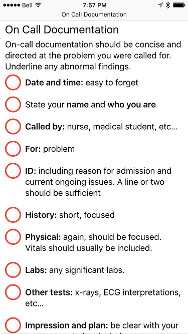Documentation
When on call, it’s not unusual to see a patient, write an order and quickly move on to the next pressing issue, forgetting to write a note in the patient’s chart. I really mean “forget”. During daytime, it’s automatic: you see a patient you write a note. Nights are different. It’s hard to describe, but the atmosphere is different. There are fewer people running around, it’s quieter, darker… And you’re busy. Very busy. So it’s easier to forget to write a note.
Residents must be careful not to forget to document issues as they happen. It’s not only common courtesy to your colleagues and allied healthcare professionals; it’s the law.
Great residents are great communicators.
Write down
- Date and time
- Your name and who you are
- Who called you
- What the problem is
- ID of the patient
- Very short, focused history of the current problem
- Physical: focused. Include vitals
- Labs: significant values
- Other tests with your interpretation (e.g. X-rays, ECGs…)
- Impression and plan
- Discussion (with patient, family, nurses)
- Don’t forget to sign your note!

Obviously, an on call note tends to be less detailed and shorter than a regular patient note. The goal is to convey the information on the acute issue while staying efficient to allow you to manage your time efficiently (i.e. go back to bed). After signing your note, make a habit of writing a few words on your patient list for handover. You think you will remember, but you won’t.
Take some time to discuss your plan with the patient’s nurse. It will make everything clearer and he/she will be able to clarify any outstanding issues at that time. A few seconds to spare you from being awakened from sleep is well worth it. More importantly, it’s just common courtesy.

Lead Author
Have thoughts to share — email me Marc-Emile@messil.com